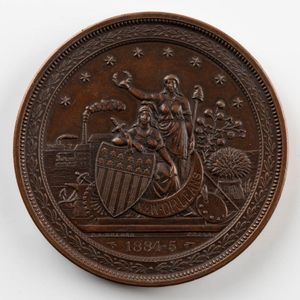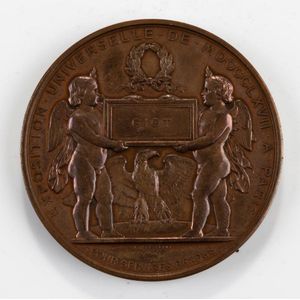Napoleon III Copper Medal for Scott Russell's Services
You must be a subscriber, and be logged in to view price and dealer details.
Subscribe Now to view actual auction price for this item
When you subscribe, you have the option of setting the currency in which to display prices to $Au, $US, $NZ or Stg.
- Laurel Leaf - The use of the laurel leaf as a decorative element can be traced back to ancient Greece and Rome, where it was closely associated with victory and honour. In these cultures, the laurel was a sacred tree that was dedicated to the god Apollo and was believed to have protective and healing properties.
In ancient Greece, the laurel wreath was awarded to victors in athletic competitions, such as the Olympic Games, as a symbol of their achievement. The wreath was also associated with academic achievement, and was often worn by scholars and poets. The Greeks also used the laurel leaf as a symbol of victory in war, and it was often depicted in artwork alongside images of triumphant warriors and heroes.
The Romans continued this tradition, and the laurel wreath became a symbol of the highest military honor, the triumph, awarded to victorious generals. The wreath was also used to crown emperors and other important officials, and was often depicted in Roman art and architecture as a symbol of power and authority.
The laurel leaf is still used as a symbol of achievement, success, and excellence, and is frequently used in logos, emblems, and other branding materials. Its association with victory and honour has made it a popular choice for awards, medals, and other forms of recognition.
This item has been included into following indexes:
- medals and medallions
- Napoleon Bonaparte and Napoleonic era - collectables and memorabilia 136
Visually similar items

Bronze medal, (75 mm, 188g) by Alexandre Geefs. Obv: Winged Prosperity hovering over sea and sunrise, trophy of arts at left. Rev: Wreath, crowned harp enclose field for winner's details.

Copper medals (44 mm) by Bouvet; one in gilt embossed round case of issue. (2).

Australian gold sovereign 1909 Melbourne

U.S.A.: bronze award medal by P.L.Krider in Philadelphia, 73 mm., obv. Industrial and agricultural scene, rev. title within wreath.
